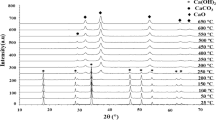Abstract
In this study, NiO reduction behavior was investigated in the gas atmosphere generated by polypropylene (PP) pyrolysis to reveal the feasibility of using polypropylene as a reducing agent precursor for metal oxides. Chemical equilibrium calculations were performed to guide the experimental studies and to better understand the processes. PP fibers and NiO powder were simultaneously heated to 600–900 K in a tubular reactor. During heating, the PP was pyrolyzed into the gaseous species as indicated by the mass measurements. NiO was reduced to Ni by the pyrolytic gas carried by Ar flow. The thermodynamic calculations predicted that the pyrolytic gas consisted of mainly H2, CH4, and C6H6. The degree of NiO reduction increased with temperature and with the pyrolyzed the PP mass. The oxide reduction was complete at 800–900 K, provided that the sufficient amount of PP was pyrolyzed. The results show that NiO reduction via PP pyrolysis route is feasible.







Similar content being viewed by others
References
S.D.A. Sharuddin, F. Abnisa, W.M.A.W. Daud, and M.K. Aroua, Energy Convers. Manag. 115, 308 (2016).
A.M. Fernández, C. Barriocanal, and R. Alvarez, J. Hazard. Mater. 203–204, 236 (2012).
S. Honus, S. Kumagaic, V. Molnárd, G. Fedorkod, and T. Yoshiokac, Fuel 22, 361 (2018).
I. Ahmad, M.I. Khan, H. Khan, M. Ishaq, R. Tariq, K. Gul, and W. Ahmad, Int. J. Green Energy 12, 663 (2015).
S. Cetinkaya and S. Eroglu, JOM 69, 993 (2017).
S. Cetinkaya and S. Eroglu, Int. J. Refract. Met. Hard Mater. 64, 184 (2017).
G. Eriksson, Chem. Scr 8, 100 (1975).
T.M. Besmann, Report No: ORNL/TM-5775 (Oak Ridge: Oak Ridge National Laboratory, 1977).
I. Barin 3rd, eds., Thermochemical Data of Pure Substances (Weinheim: VCH Verlagsgesellschaft, 2008).
M.W. Chase Jr, J. Phys. Chem. Ref. Data 9, 1 (1998).
M. Cumbul Altay and S. Eroglu, Int. J. Miner. Process. 149, 50 (2016).
J.T. Richardson, R.M. Scates, and M.V. Twigg, Appl. Catal. A 267, 35 (2004).
S.M. Al-Salem, B.K. Sharma, A.R. Khan, J.C. Arnold, S.M. Alston, S.R. Chandrasekaran, and A.T. Al-Dhafeeri, Ind. Eng. Chem. Res. 56, 5210 (2017).
S. Cetinkaya and S. Eroglu, Int. J. Miner. Process. 152, 46 (2016).
S. Cetinkaya and S. Eroğlu, JOM 69, 1997 (2017).
J. Szekely and J.W. Evans, Metall. Mater. Trans. B 2, 1699 (1971).
Q. Jeangros, T.W. Hansen, J.B. Wagner, C.D. Damsgaard, R.E. Dunin-Borkowski, C. Hébert, J. Van herle, A. Hessler-Wyser, J. Mater. Sci. 48, 2893 (2013).
A. Fivga and I. Dimitriou, Energy 149, 865 (2018).
F.P. La Mantia, Recycling of polypropylene, Polypropylene: Polymer Science and Technology Series, vol. 2, ed. by J. Karger-Kocsis (Springer, Dordrecht, 1999), pp. 701–705.
G.P. Thomas, Recycling of polypropylene (AZoCleantech Publishing, 2012). https://www.azocleantech.com/article.aspx?ArticleID=240. Accessed 24 June 2019.
Acknowledgements
This research did not receive any specific grant from funding agencies in the public, commercial, or not-for-profit sectors.
Author information
Authors and Affiliations
Corresponding author
Additional information
Publisher's Note
Springer Nature remains neutral with regard to jurisdictional claims in published maps and institutional affiliations.
Electronic Supplementary Material
Below is the link to the electronic supplementary material.
Rights and permissions
About this article
Cite this article
Cumbul Altay, M., Eroglu, S. Feasibility of Using Polypropylene for Metal Oxide Reduction. JOM 71, 3923–3930 (2019). https://doi.org/10.1007/s11837-019-03765-5
Received:
Accepted:
Published:
Issue Date:
DOI: https://doi.org/10.1007/s11837-019-03765-5




